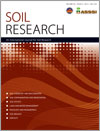SR12139Using genetic programming to transform from Australian to USDA/FAO soil particle-size classification system
Soil texture is one the most important properties of soil that determine its capacity to hold water and nutrients. The terms sand and silt, as constituent particles of soil, are parts of the common jargon, but there is not consistence in the particle size boundaries between them. This work proposes a mathematical model to transform Australian textural classes to the ones used by USDA and FAO (used in most parts of the world). This will generate a ‘common language’ within the scientific community, improving the efficiency of knowledge flow.




